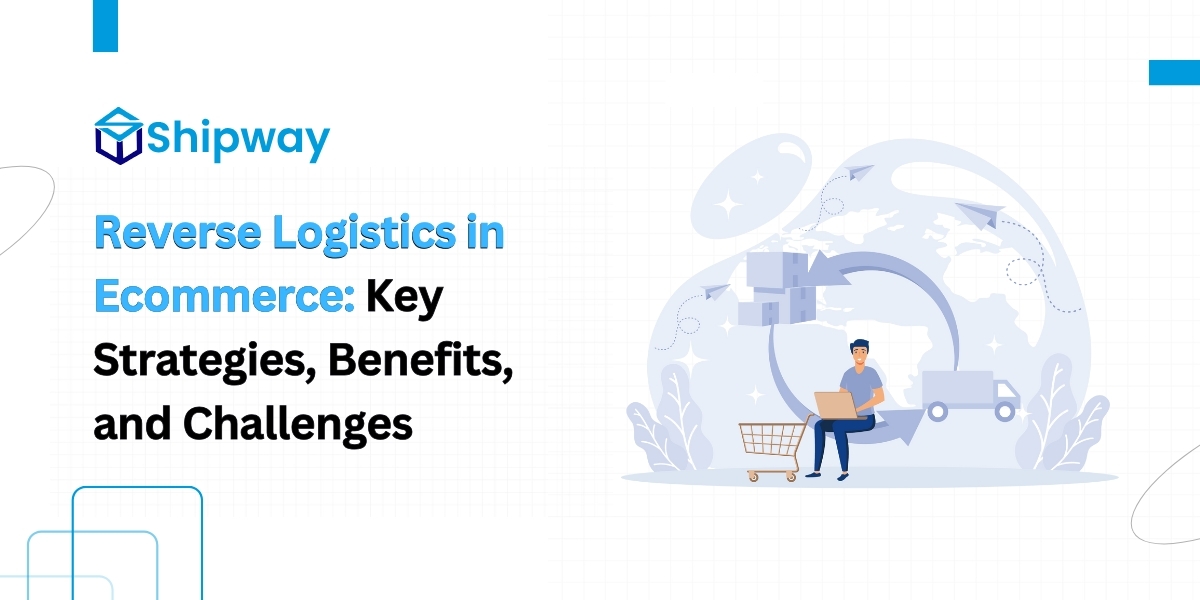The festive season rush is here and sales are skyrocketing!
But with the surge in orders, there’s also an uptick in return requests coming your way. Managing this influx of returns can be challenging for your ecommerce business.
According to sources the average e-commerce return rates are around 20-30%? And during high-demand times like the holiday season, that number can climb even higher.
But how can you streamline the entire reverse logistics process while ensuring a seamless shopping experience for your customers? How do you make sure these return orders get back to your warehouse?
In this article, we’ll break down everything you need to know about reverse logistics: what it is, why it’s essential, and how it can benefit your business. From reverse logistics process steps and strategies to overcome challenges, we’re here to guide you through.
Read on to discover how well-structured reverse logistics in ecommerce can save time, cut costs, and improve customer satisfaction.
What is Reverse Logistics?
Simply put, reverse logistics refers to the process of transporting products from a customer’s doorstep back to the merchant’s designated location. This journey begins as soon as a customer decides to return an item, whether it’s due to a wrong size, a defect, or even a change of heart.
Reverse logistics is an important component of e-commerce operations because it directly impacts customer experience. When customers know they can easily return products, it leads to a faster buying decision and a better organic word of mouth buzz for your ecommerce store.
The reverse logistics process involves several key steps: from the customer initiating the return, the ecommerce delivery partner picking up the product in its original condition, supply chain executives tracking it back to the storage facility, and ultimately returning it to the merchant’s warehouse.
However, managing reverse logistics in the supply chain can be complex and costly, with challenges like coordinating logistics, tracking shipments and minimizing losses.
To simplify and optimize reverse logistics costs, many e-commerce businesses partner with third-party logistics (3PL) providers that leverage 3PL software to automate the process. These 3PL partners specialize in reverse logistics solutions, offering a better returns management to help businesses save on costs and improve overall business efficiency.
Forward Logistics vs Reverse Logistics
For any e-commerce professional, understanding the difference between forward and reverse logistics is essential to create a smooth, efficient customer experience.
The key difference is that while forward logistics is the traditional logistics process of getting products from the supplier to the customer, reverse logistics starts when a customer decides to return an item.
Forward logistics focusses on manufacturing, inventory management, warehousing, and finally, delivery—everything designed to get orders into customers’ hands quickly and efficiently. Whereas reverse logistics involves collecting the product, checking its condition, and determining whether to restock, recycle, or dispose of it.
Balancing both is critical—because a seamless experience, whether with delivery or returns, builds customer loyalty and strengthens your brand.
This makes it crucial for ecommerce and D2C businesses to build their own strategy around reverse logistics. Building an effective returns process means thinking through some essential questions and overcoming key reverse logistics challenges.
For example, how can brands manage the high costs of return shipping? Should they absorb these costs or ask customers to share in the expense? And should they allow returns directly on their own platform, or work through a third-party provider? These choices significantly impact customer experience and the brand’s bottom line, so it’s vital to weigh each carefully.
Additionally, crafting clear and fair process guidelines for returns and exchanges can go a long way in setting customer expectations. Deciding on policies like return eligibility, restocking fees, or which items qualify for free returns helps prevent confusion and reduce friction during the returns process.
As brands face the increasing demands of today’s market, tackling these questions proactively will allow them to compete with other brands while building a more streamlined and customer-friendly reverse logistics process.
A good strategy helps business realize that reverse logistics isn’t just a cost center; when done right, it’s a powerful opportunity to build customer loyalty and stand out in a crowded ecommerce marketplace. The ability to address these logistics challenges not only improves operational efficiency but also positions brands as trustworthy and customer-focused—a winning combination in the eCommerce and D2C space.
How to Build and Optimize Your E-commerce Reverse Logistics Strategy
A well-optimized reverse logistics strategy can reduce costs, speed up returns, and improve customer satisfaction. Here are key strategies to turn reverse logistics into a growth driver for your e-commerce business:
- Create Clear Return Policies: Set up transparent return and exchange policies that address common return reasons, making it easy for customers to understand their options. Clear, fair policies not only enhance the customer experience but also set your brand apart in the reverse logistics market.
- Optimize Transportation Processes: Evaluate and streamline transportation routes to reduce shipping costs and improve efficiency. Consolidating shipments and optimizing routes can make your reverse logistics management faster and more cost-effective.
- Leverage Data-Driven Insights: Analyze returns data to uncover trends that can inform product, design, sales strategies, and logistics optimization. Using insights from reverse logistics activities helps you proactively address common return reasons and refine your approach.
- Set Up Centralized Return Centers: Establish dedicated return centers or allocate specific areas within your existing warehouses for returns. Centralized facilities accelerate the reverse logistics process and improve inventory management.
- Return Automations: Use return automation softwares to automate return processes such as order tracking, pick-up, etc. Automation provides transparency, improves processing speed and accuracy, making it easier to handle high return volumes.
- Partner with 3PL Providers: Collaborate with third-party logistics (3PL) providers to streamline reverse logistics. Strong partnerships with 3PL partners can reduce operational challenges, enhance customer experience, and ensure a smoother return process.
By implementing these reverse logistics strategies, e-commerce businesses can boost efficiency, cut costs and develop stronger customer loyalty. A well-crafted reverse logistics strategy is essential for minimizing return-related challenges and driving sustainable growth in the e-commerce industry.
Benefits of eCommerce Reverse Logistics
A well-designed reverse logistics process offers many advantages for e-commerce businesses, transforming returns into opportunities to boost profitability. Here are some of the top benefits of implementing an efficient reverse logistics solutions:
- Customer Retention: Smooth, hassle-free returns build trust and loyalty, enhancing the customer experience and increasing the likelihood of repeat purchases.
- Reduced Costs: Effective reverse logistics management lowers expenses in operations, shipping, and aftermarket services, directly impacting the bottom line and improving overall profitability.
- Enhanced Efficiency: Faster returns and processing streamline operations, helping businesses maintain high operational velocity. This efficiency leaves a lasting positive impression on customers and speeds up restocking.
- Network Transparency: Greater visibility across the return logistics network enables better inventory management and planning, allowing businesses to make data-driven decisions and improve their supply chain strategy.
Incorporating a strong reverse logistics strategy can lead to cost savings, stronger customer loyalty, and an optimized supply chain—key factors for growth in the e-commerce industry.
The Future of eCommerce Reverse Logistics
The future of eCommerce reverse logistics is all about reducing return disruptions and delivering a seamless, integrated returns process that delights customers and improves operational efficiency. Advanced supply chain technologies are transforming this space, enabling real-time tracking, data-driven decision-making, and smarter resource allocation.
These return automation tools allow businesses to minimize costs, boost efficiency, and ultimately create a hassle-free returns experience that keeps customers coming back.
Beyond just efficiency, these innovations are opening up new avenues for growth and market expansion. For instance, Blinkit is stepping into the returns space with a groundbreaking 10-minute return service—an ambitious move aimed at expanding its operations and generating additional revenue streams.
By leveraging innovative reverse logistics strategies, eCommerce businesses can create valuable growth opportunities and meet rising customer expectations in the ecommerce and D2C market.
For D2C brands, achieving this level of efficiency and customer satisfaction is now possible with Shipway’s return automation solution. Shipway empowers you to build a customized, customer-centric reverse logistics experience, complete with a DIY returns page, flexible return policies, real-time tracking and more.
With Shipway, you can optimize your D2C returns process, enhance customer loyalty, and drive sustainable growth.



